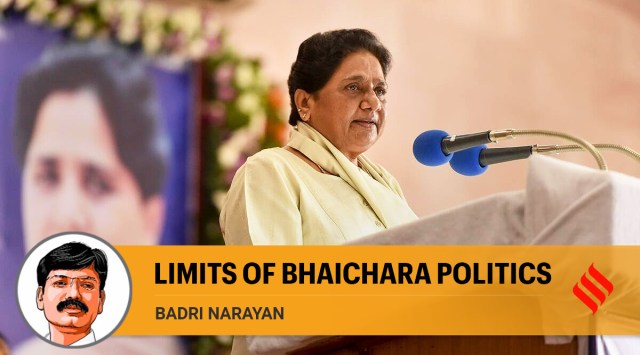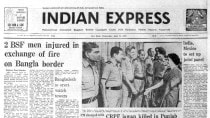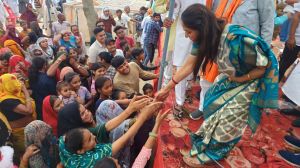- India
- International
The limits of BSP’s ‘bhaichara’ politics
Badri Narayan writes: It won’t help party at UP polls next year if the attempted Dalit-Brahmin political alliance is not backed with a social alliance.
 Bahujan Samaj Party supremo Mayawati (PTI Photo)
Bahujan Samaj Party supremo Mayawati (PTI Photo)While addressing a conference of Brahmins recently, Bahujan Samaj Party chief Mayawati said she will take care of the dignity, glory and livelihood of Brahmins and provide them proper representation in the party and the government. The BSP is trying hard to form a Dalit-Brahmin social alliance for the UP assembly election in 2022. In a way, this is an effort to revive the experiment the BSP had successfully conducted during the 2007 assembly election.
The BSP’s electoral strategy is based on forming social alliances of Dalits — its vote base — with other communities. This works in two ways: First, by providing political representation and second, through evolving social harmony or “bhaichara”. After 2007, the BSP tried to form electoral alliances with communities such as Muslims and Yadavs, but these didn’t fetch the expected returns. It, therefore, is attempting to repeat the Dalit-Brahmin alliance experiment that won the party office in 2007 for the forthcoming election.
In this form of social engineering, a community with a lower location in the social hierarchy proposes and leads an alliance with a community that has a higher location, so that they can acquire and share power. The question is whether the two social poles can come together comfortably in 2022.
Post Independence, Indian democracy had, in its own way, ruptured the functioning of the social hierarchy. Brahmins and Dalits, two social poles, started supporting the Congress together and worked politically as an alliance to acquire power. Due to various reasons, contradictions and disillusionment arose in this political alliance which, on the one hand, caused the political downfall of the Congress and, on the other, gave rise to the BSP in north India. The BSP’s own Dalit vote base is insufficient for the party to win elections. That is why it started looking for alliances with other communities. It realised that the contradiction of Dalits with the new dominant communities in UP is sharper than with the traditionally dominant communities like Brahmins. This is due to changes in rural land relations and the growing political aspirations of neo-rich, neo-dominant groups, most of whom have emerged from among the OBCs in rural Uttar Pradesh. So it was strategically comfortable for the BSP to form a Dalit-Brahmin alliance under its leadership.
After the decline of the Congress, Brahmins, as a caste, lost their importance in the politics of the state and started rallying around the BJP. The BSP had formed an alliance with the BJP in 1995 after its coalition with the Samajwadi Party failed. Thus, through various ways, Mayawati evolved the BSP’s connect with Brahmin leaders and proposed a Dalit-Brahmin alliance under the “sarvajan” agenda in 2007. This alliance succeeded because the BSP had developed a comfort level with Brahmin leaders and the community after having worked together for at least six-seven years before the election. This social alliance between Dalits and Brahmins had been forged by forming bhaichara samitis (brotherhood committees).

But this time it seems that the BSP is trying to revive a political alliance with Brahmins, which has been a major vote base for the BJP, without developing a social alliance. Dalits at the grassroots may feel comfortable while voting for the BSP along with Brahmins, but a similar socio-political comfort in the Brahmin community can’t emerge naturally. The necessary political accommodation has to be cultivated through a rigorous campaign. Merely depending on anti-incumbency or highlighting the perception of Brahmin annoyance with the BJP cannot necessarily produce a shift in allegiance at the grass roots.
Moreover, the cultural-religious symbols through which the BJP works to mobilise the public are very deeply ingrained in the hearts and minds of a major section of the Brahmin public. This has made them a long-term vote base for the BJP.
In these conditions, the BSP’s over-dependence on the Dalit-Brahmin alliance for electoral victory in 2022 may not yield the expected results. A middle-aged villager from the Jatav community in a village near Allahabad told me, “Bhaiyya, hum neeche aur upar ek ho jaye to hume kaun hara sakta hai? (When people from a lower social location and those from a higher social location come together, then who can defeat us?)” But we still need to know whether those referred to as “uparwaley” in this conversation feel comfortable in shifting their political position in the favour of the BSP.
This column first appeared in the print edition on September 22, 2021 under the title ‘Limits of bhaichara politics’. The writer is professor, Govind Ballabh Pant Social Science Institute, Allahabad
EXPRESS OPINION
More Explained
Apr 25: Latest News
- 01
- 02
- 03
- 04
- 05












































